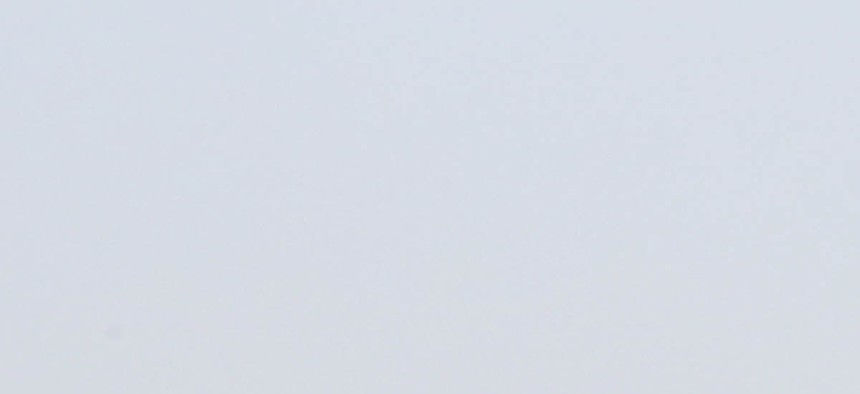
Kurdish peshmerga forces stand by their vehicles after they take control of a village from ISIS fighters, on October 1, 2014. Hadi Mizban/AP
What Obama Needs To Do To Beat ISIS
If the president is serious about dealing with the Islamic State, he will need to increase America's commitment in a measured way. By Max Boot
President Barack Obama's strategy in Syria and Iraq is not working. The president is hoping that limited air strikes, combined with U.S. support for local proxies—the peshmerga, the Iraqi security forces, the Sunni tribes, and the Free Syrian Army—will "degrade and ultimately destroy" the Islamic State of Iraq and Syria (ISIS). U.S. actions have not stopped ISIS from expanding its control into Iraq's Anbar Province and northern Syria. If the president is serious about dealing with ISIS, he will need to increase America's commitment in a measured way—to do more than what Washington is currently doing but substantially less than what it did in Iraq and Afghanistan in the past decade. And although President Obama will probably not need to send U.S. ground–combat forces to Iraq and Syria, he should not publicly rule out that option; taking the possibility of U.S. ground troops off the table reduces U.S. leverage and raises questions about its commitment.
A Big Threat
A reasonable goal for the United States would be neither to "degrade" ISIS (vague and insufficient) nor to "destroy" it (too ambitious for the present), but rather to "defeat" or "neutralize" it, ending its ability to control significant territory and reducing it to, at worst, a small terrorist group with limited reach. This is what happened with ISIS' predecessor, al-Qaeda in Iraq, during 2007 and 2008, before its rebirth amid the chaos of the Syrian civil war. It is possible to inflict a similar fate on ISIS, which, for all of its newfound strength, is less formidable and less organized than groups like Hezbollah and the Taliban, which operate with considerable state support from Iran and Pakistan, respectively. Although not as potent a fighting force as Hezbollah or the Taliban, ISIS is an even bigger threat to the United States and its allies because it has attracted thousands of foreign fighters who could return to commit acts of terrorism in their homelands.
What It Will Take to Defeat ISIS
To defeat ISIS, the president needs to dispatch more aircraft, military advisors, and special operations forces, while loosening the restrictions under which they operate. The president also needs to do a better job of mobilizing support from Sunnis in Iraq and Syria, as well as from Turkey, by showing that he is intent on deposing not only ISIS but also the equally murderous Alawite regime in Damascus. Specific steps include:
Intensify air strikes. So far, the U.S. bombing campaign against ISIS has been remarkably restrained, as revealed by a comparison with the strikes against the Taliban and al-Qaeda in Afghanistan after 9/11. When the Taliban lost control of Afghanistan between October 7, 2001, and December 23, 2001—a period of seventy-five days—U.S. aircraft flew 6,500 strike sorties and dropped 17,500 munitions. By contrast, between August 8, 2014, and October 23, 2014—seventy-six days—the United States conducted only 632 airstrikes and dropped only 1,700 munitions in Iraq and Syria. Such episodic and desultory bombing will not stop any determined military force, much less one as fanatical as ISIS.
Lift the prohibition on U.S. "boots on the ground." President Obama has not allowed U.S. Special Forces and forward air controllers to embed themselves in the Free Syrian Army, Iraqi security forces, Kurdish peshmerga, or in Sunni tribes when they go into combat as he did with the Northern Alliance in Afghanistan. This lack of eyes on the ground makes it harder to call in air strikes and to improve the combat capacity of U.S. proxies. Experience shows that "combat advisors" fighting alongside indigenous troops are far more effective than trainers confined to large bases.
Increase the size of the U.S. force. Military requirements, not a priori numbers dreamed up in Washington, should shape the force eventually dispatched. The current force, even with the recent addition of 1,500 more troops for a total of 2,900, is inadequate. Estimates of necessary troop size range from 10,000 personnel (according to General Anthony Zinni, former head of Central Command) to 25,000 (according to military analysts Kim and Fred Kagan). The total number should include Special Forces teams and forward air controllers to partner with local forces as well as logistical, intelligence, security, and air contingents in support.
Work with all of Iraq's and Syria's moderate factions. The United States should work with the peshmerga, Sunni tribes, the Free Syrian Army, and elements of the Iraqi security forces (ISF) that have not been overtaken by Iran's Quds Force, rather than simply supplying weapons to the ISF. Given Shiite militia infiltration, working exclusively through the ISF would risk empowering the Shiite sectarians whose attacks on Sunnis are ISIS' best recruiter. The United States should directly assist Sunni tribes by establishing a small forward operating base in Anbar Province, and also increase support for and coordination with the Free Syrian Army. Current plans to train only five thousand Syrian fighters next year need to be beefed up.
Send in the Joint Special Operations Command (JSOC). Between 2003 and 2010, JSOC—composed of units such as SEAL Team Six and Delta Force—became skilled at targeting the networks of al-Qaeda in Iraq. Its success was largely due to its ability to gather intelligence by interrogating prisoners and scooping up computers and documents—something that bombing alone cannot accomplish. JSOC squadrons should once again be moved to the region (they could be stationed in Iraq proper, the Kurdistan Regional Government, Turkey, and/or Jordan) to target high-level ISIS organizers.
Draw Turkey into the war. President Obama should do what he can to increase Turkey's involvement in the anti-ISIS campaign. If the Turkish army were to roll across the frontier, it could push back ISIS and establish "safe zones" for more moderate Syrian opposition members. Turkish President Recep Tayyip Erdogan has said that he will not join the fray without Washington's commitment to overthrowing Syrian President Bashar al-Assad, whom he rightly sees as the source of instability in Syria. Assuming Erdogan has honestly outlined his conditions for Turkish involvement in Syria, a greater U.S. commitment, demonstrated by a no-fly zone and airstrikes on Assad's forces, should be sufficient to entice Ankara to play a greater role.
Impose a no-fly zone over part or all of Syria. Even though U.S. aircraft are overflying Syria, they are not bombing Assad's forces. This has led to a widespread suspicion among Sunnis that the United States is now willing to keep Assad in power. More broadly, Sunnis fear that Obama is accommodating Assad's backers in Tehran to allow Iran to dominate Mesopotamia and the Levant. A no-fly zone over part or all of Syria would address these concerns and pave the way for greater Turkish involvement. The United States should act to ensure that Assad does not take advantage of the anti-ISIS campaign to bomb opposition centers. Obama could announce that no Syrian aircraft will be allowed over designated "safe zones." Such a move would garner widespread support among Arab states, undercutting attempts to portray U.S. action as a war against the Muslim world. There are legitimate concerns that overthrowing Assad now, before the Syrian opposition is ready to fill the vacuum, would be counterproductive and potentially pave the way for a jihadist takeover of all of Syria. But instituting a partial or even a complete no-fly zone would not lead to Assad's immediate ouster. It would, however, facilitate the moderate opposition's ability to organize an administration capable, with international help, of governing Syria once Assad finally goes.
Mobilize Sunni tribes. As long as the Sunni tribes of Iraq and Syria continue to tacitly support ISIS, or at least not to resist it, defeating ISIS will be almost impossible. But if the tribes turn against ISIS, as they did against al-Qaeda in Iraq in 2007, a rapid reversal of fortunes is likely. Galvanizing Sunni tribes into action will not be easy; Iraqi Sunnis feel that the United States betrayed them after the surge by leaving them under Shiite domination in Baghdad. The fact that Haidar al-Abadi replaced former Prime Minister Nouri al-Maliki in September is a good first step. But Abadi is also a Shiite from the same Dawa Party as Maliki, making it unlikely that Sunnis will fight ISIS if they once again find themselves subordinated to Shiite rule. This concern could be allayed if the United States were to engineer a political deal to grant Sunnis autonomy within the Iraqi federal structure, similar to what the Kurdistan Regional Government already enjoys. To assuage Sunnis' fear of betrayal, the United States should pledge to indefinitely maintain advise-and-assist forces in Iraq—even without Baghdad's agreement, U.S. forces could at least remain in the
Kurdish area.
Prepare now for nation-building. The United States should lay the groundwork for a postconflict settlement in both Iraq and Syria that does not necessarily require keeping both political entities intact. In the Iraqi context, this means offering greater autonomy to the Sunnis and guaranteeing the Kurds that their hard-won gains will not be jeopardized; the United States should propose to permanently station troops in the Kurdistan Regional Government. This is not necessarily synonymous with Kurdish independence, but the United States should give serious consideration to dropping its longtime opposition to the creation of a Kurdish state or possibly even two—one in Syria and one in Iraq.
Social fragmentation in Syria will make postwar reconstruction difficult; after three years of civil war, it may not be possible to reconstitute the country as it previously existed. The U.S. goal should simply be to ensure that Syrian territory is not controlled by either Shiite or Sunni extremists. The postwar settlement in the former Yugoslavia, which involved the dispatch of international peacekeepers and administrators under United Nations, European Union, and NATO mandates, could be a possible model. The United States should push UN Special Envoy for Syria Staffan de Mistura to work in cooperation with the Arab League, the EU, NATO, the United States, and even Russia to create a post-Assad administration that can win the assent of Syria's sectarian communities. As Kenneth Pollack of the Brookings Institution has suggested, "[T]he U.S. should provide most of the muscle, the Gulf states most of the money, and the international community most of the know-how." This is admittedly an ambitious goal. Neither Assad nor ISIS is in imminent danger of falling, and it will be challenging to impose any kind of order in Syria. But the United States should not repeat the mistake it made in Iraq and Libya of pushing for regime change absent a plan to fill the resulting vacuum. Admittedly even the best-laid plans can fail, but failure is guaranteed if no such plans are in place.
Down the "Slippery Slope"?
Critics will call this strategy too costly, alleging that it will push the United States down a "slippery slope" into another ground war in the Middle East. This approach will undoubtedly incur greater financial cost (dispatching ten thousand troops for a year would cost $10 billion) and higher risk of casualties among U.S. forces. But the present minimalist strategy has scant chance of success, and it risks backfiring—ISIS' prestige will be enhanced if it withstands half-hearted U.S. air strikes. Left unchecked, ISIS could expand into Lebanon, Jordan, or Saudi Arabia. Greater American involvement could galvanize U.S. allies—the most important being Turkey and the Sunni tribes of Iraq and Syria—to commit more resources to the fight. If this plan is not implemented, a major ground war involving U.S. troops becomes more probable, because the security situation will likely continue deteriorating. By contrast, this strategy, while incurring greater short-term risks, enhances the odds that ISIS will be defeated before Obama leaves office.
This post appears courtesy of CFR.org.




